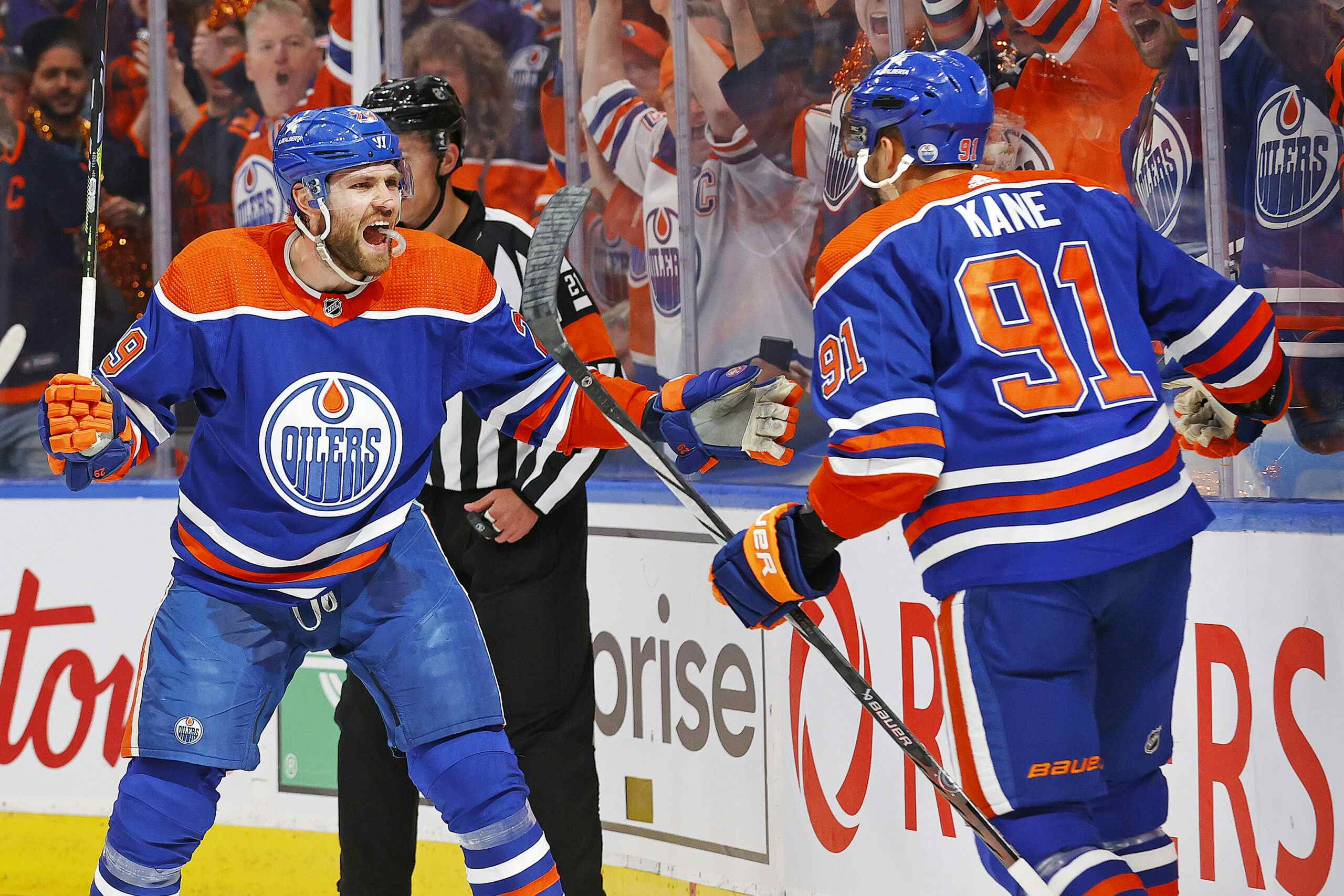Ryan Whitney’s Career Offensive Season

Ryan Whitney is a very good offensive defenseman. He was taken with a lottery pick in the 2002 NHL Draft precisely because he married strong offensive ability to a 6’4” frame, and he’s shown time and again that he is well above average in the NHL at recording points from the blue line.
During his early years in Pittsburgh, Whitney showcased that skill, most memorably with a 59 point effort in 2006-07. That mark stood as the best of his career until this past season, which I think we must note as being superior. Through 35 games prior to injury, Ryan Whitney led the Edmonton Oilers in scoring with 27 points.
How much better was Whitney’s offensive performance this year than his previous high in 2007-08? The best way to look at it is probably percentage of team offense. As of December 28, Whitney’s last game before losing his season to injury, the 15th-place Edmonton Oilers had scored 91 goals, meaning that Whitney had recorded a point on 29.7% of Oilers’ scoring plays – nearly one-third of all goals. This contrasts to his performance in 2007-08, where Whitney figured in on 21.5% of Penguins goals.
That’s a pretty big jump and I think it’s appropriate that we acknowledge just how good Ryan Whitney was last season. His offensive performance was comparable to this year’s scoring leader among defenseman (and the man Whitney was traded for), Lubomir Visnovsky, who recorded points on 29.3% of all Anaheim Ducks goals.
The question that needs to be asked is this: does Whitney’s spectacular 2010-11 performance seem likely to be repeated? Was this a one-off, or can the Oilers bank on this level of production from Whitney whenever he’s healthy?
To shed some light on that question, I thought it would be helpful to go back over Whitney’s career and review his ice-time, as well as to see how he’s scored in different situations.
Whitney’s Career Ice-Time
| Season | Games | EV Minutes/GM | PP Minutes/GM | SH Minutes/GM |
|---|---|---|---|---|
| 2005-06 | 68 | 14.93 | 4.53 | 4.33 |
| 2006-07 | 81 | 15.67 | 5.98 | 2.26 |
| 2007-08 | 76 | 14.97 | 5.23 | 2.23 |
| 2008-09 | 48 | 17.66 | 4.46 | 1.70 |
| 2009-10 | 81 | 18.41 | 3.72 | 2.50 |
| 2005-10 Avg. | 71 | 16.33 | 4.78 | 2.60 |
| 2010-11 | 35 | 18.32 | 4.32 | 2.70 |
We can see that Whitney’s even-strength ice-time has jumped since leaving the Penguins. 2008-09 was the first season where Whitney topped 17 minutes per game, and he’s topped 18 in the two seasons since. His power play ice-time has taken a hit, possibly as a result; after back-to-back seasons of more than five minutes per game, Whitney’s been below that mark for three consecutive seasons. His short-handed ice-time peaked this year to its highest level since Whitney’s rookie season.
Whitney’s Scoring
| Season | EVPTS | PPPTS | SHPTS | EVPTS/60 | PPPTS/60 | SHPTS/60 |
|---|---|---|---|---|---|---|
| 2005-06 | 21 | 16 | 1 | 1.24 | 3.12 | 0.20 |
| 2006-07 | 25 | 33 | 1 | 1.18 | 4.09 | 0.33 |
| 2007-08 | 17 | 22 | 1 | 0.90 | 3.32 | 0.35 |
| 2008-09 | 12 | 11 | 0 | 0.85 | 3.08 | 0.00 |
| 2009-10 | 22 | 17 | 0 | 0.89 | 3.39 | 0.00 |
| 2005-10 Avg. | 19 | 20 | 1 | 1.01 | 3.51 | 0.20 |
| 2010-11 | 18 | 7 | 2 | 1.68 | 2.78 | 1.27 |
A quick glance at the bottom two lines shows us that Whitney’s big offensive breakthrough came almost exclusively at even-strength. In less than half as many games, he came within a single point of hitting his career average even-strength point production.
On a per/60 basis, Whitney’s even-strength scoring had been in decline since his rookie year (I’d suggest, although the data isn’t available to prove it, that this is at least in part a result of playing tougher minutes at evens), settling in at between 0.85 and 0.90 over the last three seasons. It nearly doubled this season, jumping to 1.68 PTS/60. How good a number is that?
From Behind the Net, the defensive league leaders (min 40GP) in 5-on-5 PTS/60 since 2007-08:
| Season | Player | 5v5 PTS/60 |
|---|---|---|
| 2007-08 | Niklas Kronvall | 1.61 |
| 2008-09 | Mike Green | 1.58 |
| 2009-10 | Mike Green | 1.77 |
| 2010-11 | Brian Rafalski | 1.66 |
Put another way: it’s a number so good that only one defenseman in the last four seasons has been able to top it.
Based on the twin facts that Whitney’s even-strength point production this season was a) nearly twice his average over the last three seasons and b) better than anything anyone not named Mike Green has managed over the last four years, I think the conclusion is obvious: It is highly likely that Whitney’s even-strength scoring will regress next season.
What about Whitney’s power play scoring? After all, it hit the lowest level of his career this season, surely there’s room for improvement there?
Yes and no. Before I clarify, a look at the power play units that Whitney has been a part of over the course of his career:
| Season | Team | PP Efficiency | NHL Rank | PP Goals |
|---|---|---|---|---|
| 2005-06 | Pittsburgh | 19.0% | 6th | 94 |
| 2006-07 | Pittsburgh | 20.3% | 5th | 94 |
| 2007-08 | Pittsburgh | 20.4% | 4th | 77 |
| 2008-09 | Pittsburgh | 17.2% | 20th | 62 |
| 2008-09 | Anaheim | 23.6% | 5th | 73 |
| 2009-10 | Anaheim | 21.0% | 5th | 63 |
| 2009-10 | Edmonton | 17.3% | 18th | 52 |
| 2010-11 | Edmonton | 14.5% | 27th | 44 |
It’s not a coincidence that Whitney’s power play numbers took a dive after coming over to Edmonton: this was the first time in his career he’s had to spend his whole season on anything other than an elite NHL power play.
Therein lies the problem: to put up a lot of power play points, a player needs to play on a good power play. Certainly there’s reason for optimism in Edmonton; between advancement from young players like Hall, Eberle and Gagner and the awful year Hemsky (and others) had on the man advantage, there’s little place to go but up. However, there’s little reason to believe that the Oilers are going to have a top-five power play in the near future.
The other issue is that teams get less power play time now than they did at the start of the post-lockout era. A look at the above chart clearly shows that – in 2006-07, the league’s fifth-best power play scored 94 goals; in 2009-10 that number had dropped by one-third, down to 63. Fewer power play opportunities mean fewer points for players like Whitney.
Finally, a note on the short-handed scoring: yes, Whitney’s per/60 number is insanely good, but the fact that it will drop doesn’t matter because short-handed scoring is such a tiny part of Whitney’s point production (two of his points this year came with the Oilers down a man).
Recent articles from Jonathan Willis





